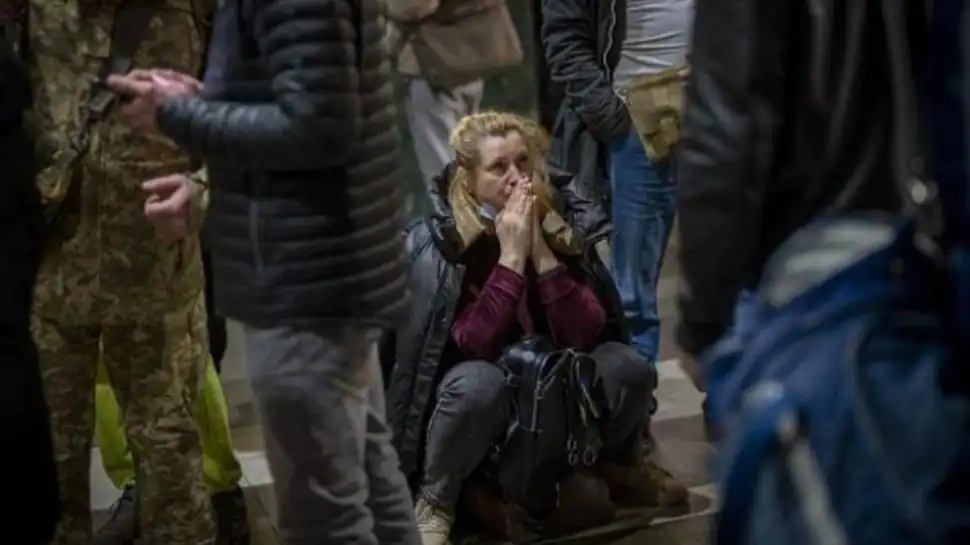After weeks of ferocious fighting, Ukrainian forces have begun retreating from a besieged city in the country’s east to move to stronger positions, a regional official said Friday, the four-month mark in Russia’s invasion.
The planned withdrawal from Sievierodonetsk, the administrative centre of the Luhansk region, comes after relentless Russian bombardment that has reduced most of the industrial city to rubble and cut its population from 100,0000 to 10,000. Ukrainian troops fought the Russians in house-to-house battles before retreating to the huge Azot chemical factory on the city’s edge, where they remain holed up in its sprawling underground structures in which about 500 civilians also found refuge.
In recent days, Russian forces have made gains around Sievierodonetsk and the neighbouring city of Lysychansk, on a steep bank across a river, in a bid to encircle Ukrainian forces.
Sievierodonetsk and Lysychansk have been the focal point of the Russian offensive aimed at capturing all of the Donbas and destroying the Ukrainian military defending it — the most capable and battle-hardened segment of the country’s armed forces. The two cities and surrounding areas are the last major pockets of Ukrainian resistance in the Luhansk region — 95 per cent of which is under Russian and local separatist forces’ control. The Russians and separatists also control about half of the Donetsk region, the second province in the Donbas.
Russia used its numerical advantages in troops and weapons to pummel Sievierodonetsk in what has become a war of attrition, while Ukraine clamoured for better and more weapons from its Western allies. Bridges to the city were destroyed, slowing the Ukrainian military’s ability to resupply, reinforce and evacuate the wounded and others. Much of the city’s electricity, water and communications infrastructure has been destroyed.
Luhansk Governor Serhiy Haidai said Ukrainian troops have been ordered to leave Sievierodonetsk to prevent bigger losses and move to better fortified positions. The head of the regional administration, Roman Vlasenko, said the withdrawal has already begun and will take several days.
“As of now, the Ukrainian military still remains in Sievierodonetsk,” Vlasenko told CNN. “They are being withdrawn from the city at the moment. It started yesterday.” Ukraine’s military spokesman declined to confirm the retreat order, saying government policy prevents comments on Ukrainian troop movements.
“Regrettably, we will have to pull our troops out of Sievierodonetsk,” Haidai told The Associated Press. “It makes no sense to stay at the destroyed positions, and the number of killed in action has been growing.” A senior US defense official, speaking in Washington on condition of anonymity, on Friday called the Ukrainians’ move a “tactical retrograde” to consolidate forces into positions where they can better defend themselves. This will add to Ukraine’s effort to keep Russian forces pinned down longer in a small area, the official said.
Haidai noted that while the retreat is under way, some Ukrainian troops remain in Sievierodonetsk, facing Russian bombardment that has destroyed 80 per cent of buildings.
“As of today, the resistance in Sievierodonetsk is continuing,” Haidai told the AP. “The Russians are relentlessly shelling the Ukrainian positions, burning everything out.” Haidai said the Russians are also advancing toward Lysychansk — from Zolote and Toshkivka — adding that Russian reconnaissance units conducted forays on the city’s edges but its defenders drove them out. The governor added that a bridge leading to Lysychansk was badly damaged in a Russian airstrike and is unusable for trucks. Ukrainian military analyst Oleg Zhdanov told the AP that some of the troops moving away from Sievierodonetsk are heading to the fight in Lysychansk.
In other battlefield reports, the Russian Defense Ministry declared Friday that four Ukrainian battalions and a unit of “foreign mercenaries” totalling about 2,000 soldiers have been “fully blocked” near Hirske and Zolote, south of Lysychansk. The claim couldn’t be independently verified.
Following a botched attempt to capture Kyiv, Ukraine’s capital, in the early stage of the invasion that started February 24, Russian forces have shifted their focus to the Donbas, where the Ukrainian forces have fought Moscow-backed separatists since 2014.
After repeated requests to its Western allies for heavier weaponry to counter Russia’s edge in firepower, four medium-range American rocket launchers have arrived, with four more on the way. The senior US defense official said Friday that more Ukrainian forces are training outside Ukraine to use the High Mobility Artillery Rocket Systems, or HIMARS, and are expected back in their country with the weapons by mid-July.
The rockets can travel about 70 kilometers. Also to be sent are 18 US coastal and river patrol boats. The official said there is no evidence Russia has been successful in intercepting any of what has been a steady flow of military aid into Ukraine from the US and other nations. Russia has repeatedly threatened to strike, or actually claimed to have hit, such shipments.













